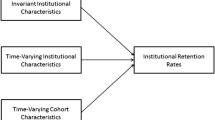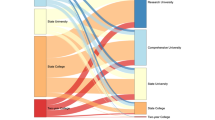Abstract
The impact of increased academic intensity on transfer rates from community colleges to 4-year institutions has been estimated only from observational data, with the possibility of selection bias. This study uses matching estimators to overcome possible selection bias and estimate the causal impact of increased academic intensity on transfer rates. Using student unit record data from Tennessee for the years 1995 through 2004, I find that taking 12 or more credit hours increases the probability of transfer from between 11% and 15%.





Similar content being viewed by others
Notes
“Higher" and “lower" numbers of hours are defined variably in this study. As explained in the methods section, I use cutoffs of 6, 9, and 12 h to define higher and lower numbers of credit hours.
See Heckman and Robb (1985) for a complete discussion.
Distance traveled is measured as the distance from the student's county of origin to the institution's zip code area.
Logistic regression is utilized for ease of comparison between these results and other studies of transfer. Results for simple z-tests for differences of proportions are identical.
References
Adelman, C. (1999). Answers in the tool box: Academic intensity, attendance patterns, and bachelor’s degree attainment. Technical report, United States Department of Education, Washington, DC.
Adelman, C. (2004). Principal indicators of student academic histories in postsecondary education. Technical report, United States Department of Education.
Adelman, C. (2006). The toolbox revisited: Paths to degree completion from high school through college. Technical report, United States Department of Education, Washington, DC.
Agodini, R., & Dynarski, M. (2004). Are experiments the only option? A look at dropout prevention programs. The Review of Economics and Statistics, 86(1), 180–194.
Anderson, G. M., Alfonso, M., & Sun, J. C. (2006). Rethinking cooling out at public community colleges: An examination of fiscal and demographic trends in higher education and the rise of statewide articulation agreements. Teachers College Record, 108(3), 422–451.
Angrist, J. D. (1998). Estimating the labor market impact of voluntary military service using social security data on military applicants. Econometrica, 66(2), 249–288.
Angrist, J. & Krueger, A. (1998). Empirical strategies in labor economics. Working Papers. Princeton Department of Economics-Industrial Relations Section.
Bailey, T., & Weininger, E. B. (2002). Performance, graduation, and transfer of immigrants and natives in City University of New York community colleges. Educational Evaluation and Policy Analysis, 24(4), 359–377.
Barefoot, B. O., Gardner, J. N., Cutright, M., Morris, L. V., Schroeder, C. C., Schwartz, S. W., et al. (2005). Achieving and sustaining institutional excellence for the first year of college. San Francisco: Jossey-Bass.
Bauer, P. F., & Bauer, K. W. (1994). The community-college as an academic bridge—academic and personal concerns of community-college students before and after transferring to a 4-year institution. College and University, 69(3), 116–122.
Bradburn, E. M., & Hurst, D. G. (2001). Community college transfer rates to 4-year institutions using alternative definitions of transfer. Technical report, United States Department of Education, National Center for Education Statistics, Washington, DC.
Braxton, J., Milem, J. F., & Sullivan, A. S. (2000). The influence of active learning on the college student departure process. Journal of Higher Education, 71(5), 569–590.
Card, D., & Sullivan, D. G. (1988). Measuring the effect of subsidized training programs on movements in and out of employment. Econometrica, 56(3), 497–530.
Cheslock, J. J. (2005). Differences between public and private institutions of higher education in the enrollment of transfer students. Economics of Education Review, 24(3), 263–274.
D’Agostino, R. B. (1998). Propensity score methods for bias reduction in the comparison of a treatment to a non-randomized control group. Statistics in Medicine, 17, 2265–2281.
Dehejia, R. H., & Wahba, S. (1999). Causal effects in nonexperimental studies: Reevaluation the evaluation of training programs. Journal of the American Statistical Association, 94(448), 1053–1062.
Dehejia, R. H., & Wahba, S. (2002). Propensity score-matching methods for nonexperimental causal studies. The Review of Economics and Statistics, 84(1), 151–161.
Dougherty, K. J., & Kienzl, G. S. (2006). It’s not enough to get through the open door: Inequalities by social background in transfer from community colleges to 4-year colleges. Teachers College Record, 108(3), 452–487.
Fortin, B., Lacroix, G., & Drolet, S. (2004). Welfare benefits and the duration of welfare spells: Evidence from a natural experiment in Canada. Journal of Public Economics, 88(7–8), 1495–1520.
Grubb, N. W. (1991). The decline of community college transfer rates: Evidence from national longitudinal surveys. The Journal of Higher Education, 62(2), 194–222.
Hahn, J., Todd, P., & Van der Klaauw, W. (2001). Identification and estimation of treatment effects with a regression-discontinuity design. Econometrica, 69(1), 201–209.
Heckman, J. (1979). Sample selection bias as a specification error. Econometrica, 46, 931–961.
Heckman, J., Ichimura, H., Smith, J., & Todd, P. (1998a). Characterizing selection bias using experimental data. Econometrica, 66(5), 1017–1098.
Heckman, J. J., Ichimura, H., & Todd, P. E. (1997). Matching as an econometric evaluation estimator: Evidence from evaluating a job training program. The Review of Economic Studies, 64(4), 605–654.
Heckman, J. J., Ichimura, H., & Todd, P. E. (1998b). Matching as an econometric evaluation estimator. The Review of Economic Studies, 65(2), 261–294.
Heckman, J., & Robb, R. (1985). Longitudinal analysis of labor market data, chapter alternative methods for evaluating the impact of interventions (pp. 156–245). New York: Cambridge University Press.
Hilmer, M. J. (1997). Does community college attendance provide a strategic path to a higher quality education? Economics of Education Review, 16(1), 59–68.
Ho, D. E., Imai, K., King, G., & Stuart, E. A. (2005). Matching as nonparametric preprocessing for reducing model dependence in parametric causal inference. Cambridge: Harvard University.
Holland, P. W. (1986). Statistics and causal inference. Journal of the American Statistical Association, 81(396), 945–960.
Kane, T. (1999). Has financial aid policy succeeded in ensuring access to college? In The price of admission. Washington, DC: Brookings.
Kane, T. J., & Rouse, C. E. (1995). Labor-market returns to 2-year and 4-year college. American Economic Review, 85(3), 600–614.
Lee, V. E., & Frank, K. A. (1990). Students characteristics that facilitate the transfer from 2-year to 4-year colleges. Sociology of Education, 63(3), 178–193.
Lee, V. E., Mackielewis, C., & Marks, H. M. (1993). Persistence to the baccalaureate degree for students who transfer from community-college. American Journal of Education, 102(1), 80–114.
Leigh, D. E., & Gill, A. M. (2003). Do community colleges really divert students from earning bachelor’s degrees? Economics of Education Review, 22(1), 23–30.
Leigh, D. E., & Gill, A. M. (2004). The effect of community colleges on changing students’ educational aspirations. Economics of Education Review, 23(1), 95–102.
Lemieux, T., & Milligan, K. (2006). Incentive effects of social assistance: A regression discontinuity approach. Analytical Studies Branch Research Paper Series 2006280e, Statistics Canada, Analytical Studies Branch.
Light, A., & Strayer, W. (2004). Who receives the college wage premium? Assessing the labor market returns to degrees and college transfer patterns. Journal of Human Resources, 39(3), 746–773.
Morgan, S. L., & Harding, D. J. (2006). Matching estimators of causal effects: Prospects and pitfalls in theory and practice. Sociological Methods and Research, 35(1), 3–60.
Prager, C. (1993). Transfer and articulation within colleges and universities. Journal of Higher Education, 64(5), 539–554.
Rosenbaum, P. R., & Rubin, D. B. (1983). The central role of the propensity score in observational studies for causal effects. Biometrika, 70(1), 41–55.
Rosenbaum, P. R., & Rubin, D. B. (1985). Constructing a control group using multivariate matched sampling methods that incorporate the propensity score. American Statistician, 39, 33–38.
Rouse, C. E. (1995). Democratization or diversion—the effect of community-colleges on educational-attainment. Journal of Business & Economic Statistics, 13(2), 217–224.
Rouse, C. E. (1998). Do 2-year colleges increase overall educational attainment? Evidence from the states. Journal of Policy Analysis And Management, 17(4), 595–620.
Rubin, D. B. (1974). Estimating causal effects of treatments in randomized and nonrandomized studies. Journal of Educational Psychology, 66, 688–701.
Rubin, D. B. (1976). Assignment of treatment group on the basis of a covariate. Journal of Educational Statistics, 2, 1–26.
Rubin, D., & Neal, T. (2000). Combining propensity score matching with additional adjustments for prognostic covariates. Journal of the American Statistical Association, 95(450), 573–585.
Shaw, K. M., & Coleman, A. B. (2000). Humble on sundays: Family, friends, and faculty in the upward mobility experiences of African American females. Anthropology & Education Quarterly, 31(4), 449–470.
Shaw, K. M., & London, H. B. (2001). Culture and ideology in keeping transfer commitment: Three community colleges. Review of Higher Education, 25(1), 91.
Shulock, N., & Moore, C. (2005). Diminished access to the baccalaureate for low-income and minority students in california: The impact of budget and capacity constraints on the transfer function. Educational Policy, 19(2), 418–442.
Smith, J. A., & Todd, P. E. (2001). Reconciling conflicting evidence on the performance of propensity-score matching methods. The American Economic Review, 91(2), 112–118.
Surette, B. J. (2001). Transfer from 2-year to 4-year college: an analysis of gender differences. Economics of Education Review, 20(2), 151–163.
Tinto, V. (1975). Dropout from higher education: A theoretical synthesis of recent research. Review of Educational Research, 45(1), 89–125.
Townsend, B. K. (1995). Community-college transfer students—a case-study of survival. Review of Higher Education, 18(2), 175–193.
United States Department of Education (2005). Beginning postsecondary students: Data analysis system. Technical report, National Center for Education Statistics.
U.S. Department of Education (2004). Digest of education statistics, 2002. Technical report, National Center for Education Statistics.
Vinha, K. (2002). A primer on propensity score matching estimators. Documents Cede 001928, Universidad de los Andes Cede.
Wassmer, R., Moore, C., & Shulock, N. (2004). Effect of racial/ethnic composition on transfer rates in community colleges: Implications for policy and practice. Research in Higher Education, 45(6), 651–672.
Acknowledgements
The author gratefully acknowledges the staff at the Tennesse Higher Education Commission, who provided the data for this study. Linda Sax, John Chesslock, and Jennifer Delaney all provided detailed comments and suggestions that improved the paper. Last, the author would like to thank the editor and two anonymous reviewers for their thoughtful and constructive comments. The author bears sole responsibility for the content of this paper.
Author information
Authors and Affiliations
Corresponding author
Rights and permissions
About this article
Cite this article
Doyle, W.R. Impact of Increased Academic Intensity on Transfer Rates: An Application of Matching Estimators to Student-Unit Record Data. Res High Educ 50, 52–72 (2009). https://doi.org/10.1007/s11162-008-9107-6
Received:
Accepted:
Published:
Issue Date:
DOI: https://doi.org/10.1007/s11162-008-9107-6




